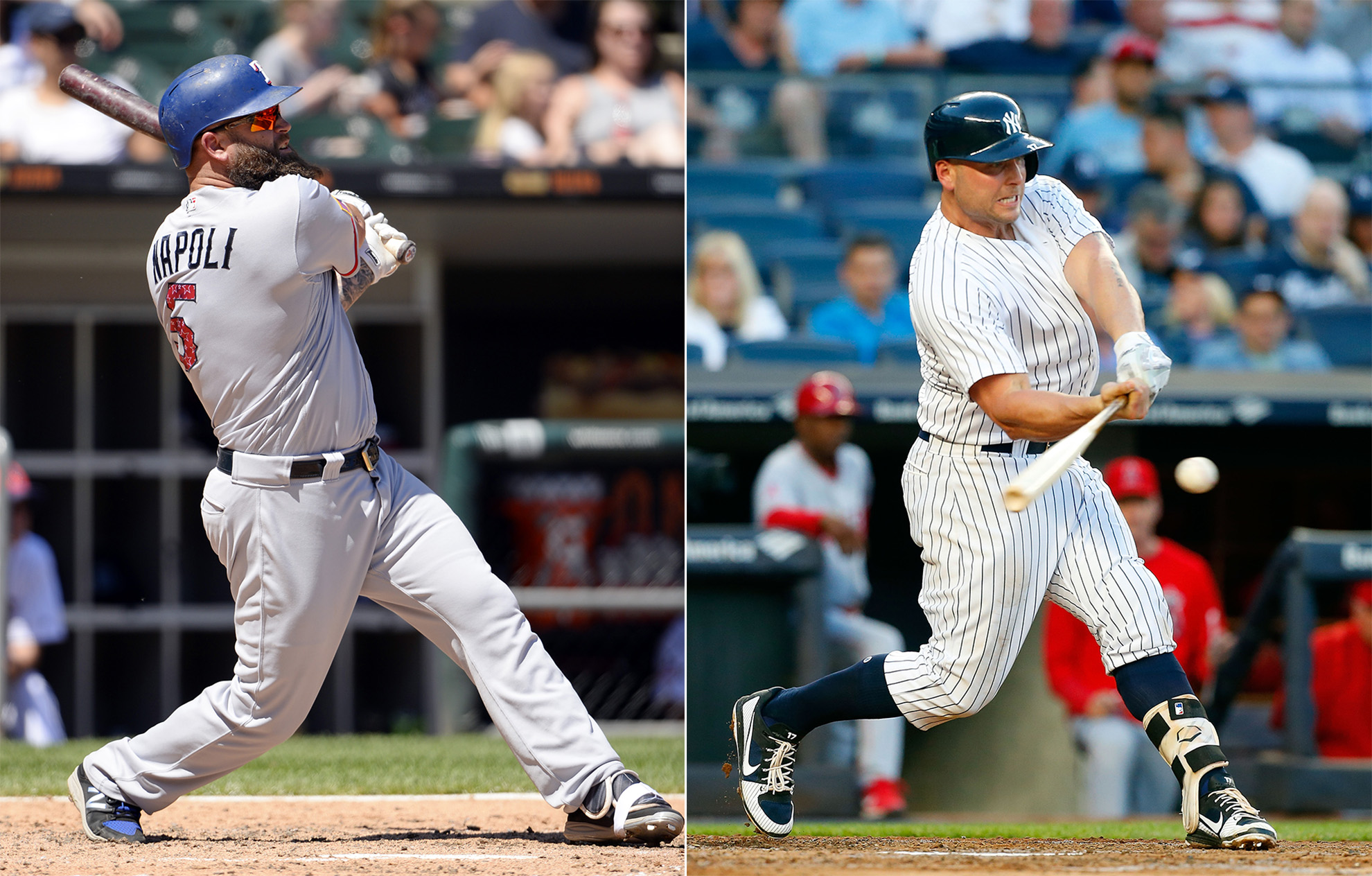
Mike Napoli and Matt Holliday could help their teams in a big way after the All-Star break. (Getty Images)
With the 2017 Major League Baseball season on pause for the All-Star break, let’s take a look at which players on contending teams have histories of strong second-half performances. This might portend favorably for their current teams.
Mike Napoli, 1B/DH, Rangers
Napoli’s third stint with the Rangers got off to a rough start. Despite his 18 first-half home runs, he came into the break hitting just .194 with a .273 OBP and 92 strikeouts in 72 games. However, the Rangers and their fans know first-hand about Napoli’s knack for a second-half flourish. Napoli had a similarly poor start with Boston in 2015, but hit .295/.396/.513 after an Aug. 7 trade to Texas. Over twelve MLB seasons, he has hit .240/.337/.455 in the first half, but surged to .262/.365/.515 in the second half, an improvement of 88 points of OPS.
If you’re questioning the Rangers’ status as contenders, consider that they currently have the same record as the Cubs and are just three games out of the second Wild Card spot in the American League. What’s more, Napoli isn’t their only veteran with a history of second-half improvements. Adrian Beltre, who missed most of the first half due to injury, has a career second-half OPS 74 points better than his first-half mark. Shin-Soo Choo typically raises his OPS 63 points, on average, in the second half, and lefty Cole Hamels, who also missed much of the first half due to injury, has a career second-half ERA of 3.05, 48 points lower than his first-half mark.
Ryan Zimmerman, 1B, Nationals
It’s difficult to imagine Zimmerman improving on his first-half performance, given that his current 146 OPS+ is a career high. Nonetheless, his extensive personal history tells us that the 13-year veteran tends to improve after the All-Star break, from a career mark of .268/.331/.454 in the first half to .297/.361/.498 in the second half, a 74-point improvement in OPS. That trend may be counteracted by some correction to his hot start this year, but it still suggests that a big fall-off is unlikely for the longtime Nationals star. Other Nats with a history of second half improvement include Jayson Werth, with a second-half OPS 51 points higher than his first-half mark over his career, and Stephen Strasburg, who has held hitters to a .215/.261/.350 line after the break in his career.
Matt Holliday, DH/1B, Yankees
Holliday’s expected return from illness to open the second half on Friday could be exactly what the Yankees need. With the team struggling to populate first base, the 37-year-old veteran could help out on both sides of the ball, entering the first-base mix (he has seven starts there already this year and 16 total since the start of 2016) and helping to reverse the downturn the offense experienced before the break: Holliday is a career .308/.387/.542 hitter in the second half.
Rick Porcello, RHP, Red Sox
Porcello won the AL Cy Young Award last year on the strength of his second-half performance, going 14-2 with a 2.58 ERA, 0.92 WHIP and 7.71 strikeout-to-walk ratio from June 28 through the end of the season. That, in turn, built on his strong post-DL showing down the stretch in 2015 (3.14 ERA, 5.18 K/BB). On his career, he has posted an ERA 81 points lower in the second half than in the first half, with improved peripherals to match. Given how unlucky Porcello has been on balls in play thus far this year (.346 BABIP), the correction he’s due could give him an extra boost, as his fielding independent pitching mark is already 68 points lower than his actual ERA this season. The Red Sox can also look forward to a strong finish from Mookie Betts, a .320/.377/.510 second-half hitter in his previous two and a half seasons.
Justin Grimm, RHP, Cubs
You probably weren’t expecting to find Grimm on this list, but the disparity between the righty reliever’s first- and second-half performances was the largest we could find among players on ostensible contenders. Now in his sixth Major League season, the 28-year old has posted a 5.33 ERA in games prior to the All-Star break but a 2.60 mark in the second half, while holding hitters to a .199/.275/.274 line after the All-Star Game. Yes, his stint as a starter in Texas in the first half of the 2013 season puts a thumb on the scale to some degree. Still, as a pure reliever for the eventual world champions last year, Grimm had a 5.34 ERA in 40 games in the first half and a 2.42 ERA in 28 games in the second half. He was excellent overall in 2015, but in 2014 — again pitching purely in relief — he had a 4.57 first-half ERA and a 2.60 second-half mark. Arguably, Grimm has already turned that corner this season, posting a 7.53 ERA through early May, prompting a brief demotion, and a 2.41 ERA since his return later that month.
The Cubs can also be optimistic about 42-year-old Koji Uehara in the second half, as he has posted a 1.95 ERA with a staggering 17.09 K/BB in his career in the second half, compared to 2.82 and 5.63 before the break. More encouragingly, given that the bullpen is the one part of the Cubs’ roster that didn’t underperform in the first half, Jayson Heyward has posted an OPS 48 points higher in the second half than in the first half over the course of his career, though last season was a glaring exception to that trend.
[“Source-sportsonearth”]
